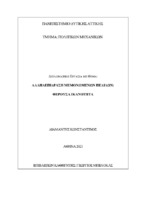| dc.contributor.advisor | Belokas, Georgios | |
| dc.contributor.author | Διαμαντής, Κωνσταντίνος | |
| dc.date.accessioned | 2021-07-27T14:07:35Z | |
| dc.date.available | 2021-07-27T14:07:35Z | |
| dc.date.issued | 2021-07-23 | |
| dc.identifier.uri | https://polynoe.lib.uniwa.gr/xmlui/handle/11400/972 | |
| dc.identifier.uri | http://dx.doi.org/10.26265/polynoe-823 | |
| dc.description.abstract | Η φέρουσα ικανότητα αποτελεί πρωταρχικό μέλημα στη θεμελίωση τεχνικών έργων. Το ίδιο βάρος της κατασκευής, αλλά και τα επιπλέον φορτία πρέπει να μεταφέρονται στο έδαφος με ασφάλεια και οικονομία. Αν και πολλοί επιστήμονες έχουν ερευνήσει θεωρητικά και πειραματικά το μηχανισμό αστοχίας και εκτιμήσει τη φέρουσα ικανότητα εδάφους κάτω από ένα μεμονωμένο θεμέλιο, μόνο λίγοι έχουν επικεντρωθεί στην κατανόηση της αλληλεπίδρασης δυο πεδίλων. Στην παρούσα διπλωματική εργασία, αριθμητικές αναλύσεις μέσω του λογισμικού Phase2 πραγματοποιήθηκαν, με σκοπό να διερευνηθεί η μεταβολή της φέρουσας ικανότητας συγκριτικά με την απόσταση των θεμελίων. Αρχικά, αναλύσεις εκτελέστηκαν σε μεμονωμένα τραχιά θεμέλια, εδρασμένα σε μη συνεκτικά εδάφη. Η φέρουσα ικανότητα (qu) καθώς και ο συντελεστής φέρουσας ικανότητας (Νγ) προσδιορίστηκαν και συγκρίθηκαν με προηγούμενες μελέτες. Στη συνέχεια, πραγματοποιήθηκαν δοκιμές σε δυο τραχιά επιφανειακά θεμέλια, εδρασμένα στα ίδια εδάφη με τα μεμονωμένα, ο συντελεστής αλληλεπίδρασης (ξγ) υπολογίστηκε και οι μηχανισμοί αστοχίας των εδαφών παρουσιάστηκαν. Επίσης, διαγράμματα του συντελεστή ξγ συναρτήσει της κανονικοποιημένης απόστασης (S/B) για διάφορες γωνίες εσωτερικής τριβής (φ) κατασκευάστηκαν και συγκρίθηκαν με προηγούμενες θεωρητικές, πειραματικές και αριθμητικές μελέτες. | el |
| dc.format.extent | 146 | el |
| dc.language.iso | el | el |
| dc.publisher | Πανεπιστήμιο Δυτικής Αττικής | el |
| dc.rights | Αναφορά Δημιουργού - Μη Εμπορική Χρήση - Παρόμοια Διανομή 4.0 Διεθνές | * |
| dc.rights.uri | https://creativecommons.org/licenses/by-nc-sa/4.0/deed.el | * |
| dc.subject | Φέρουσα ικανότητα | el |
| dc.subject | Αλληλεπίδραση πεδίλων | el |
| dc.subject | Έδαφος | el |
| dc.subject | Θεμελίωση | el |
| dc.subject | Διατμητικές αστοχίες | el |
| dc.title | Αλληλεπίδραση μεμονωμένων πεδίλων: φέρουσα ικανότητα | el |
| dc.title.alternative | Interaction of spread footings on determining bearing capacity | el |
| dc.type | Διπλωματική εργασία | el |
| dc.contributor.committee | Συμπέθερος, Ιωάννης | |
| dc.contributor.committee | Βαλαβανίδης, Μάριος-Προκόπιος | |
| dc.contributor.faculty | Σχολή Μηχανικών | el |
| dc.contributor.department | Τμήμα Πολιτικών Μηχανικών | el |
| dc.description.abstracttranslated | The bearing capacity of the foundation is a primary concern in the field of foundation engineering. The self-weight of the structure and the applied loading should be transferred to the soil safely and economically. Although, many researchers have theoretically and experimentally investigated the mechanisms of failure and estimated the bearing capacity of soil beneath an isolated foundation, only few have been focused on the determination of the interfering effect of two nearby strip footings. In this thesis, a numerical model is developed using Phase2 (Finite Element Method, FEM) with the aim of examining the variation of the ultimate bearing capacity with respect to the spacing between the two footings. Firstly, the software was performed on rough single footings, resting on a cohesionless soil. Τhe bearing capacity (qu) as well as the bearing capacity factor (Nγ) was determined and compared with previous studies. After that, tests were carried out to two closely spaced rough footings based on the above- mentioned soils, the interference factor (ξγ) was calculated and the failure mechanisms were presented. Moreover, diagrams between ξγ and spacing (S/B) were illustrated for variable friction angles and they were compared with existing experimental, theoretical and numerical researches. | el |


